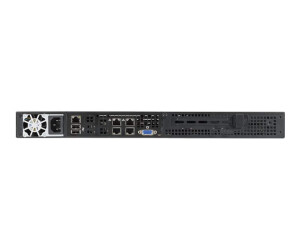
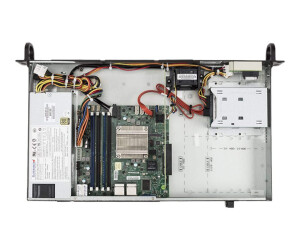
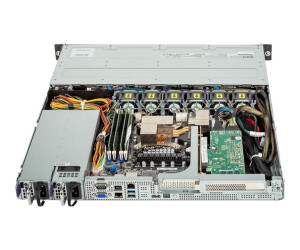
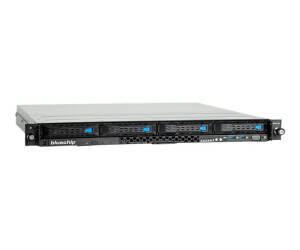








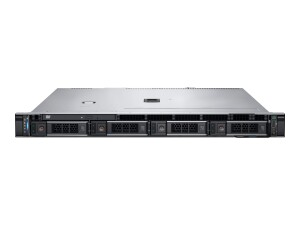
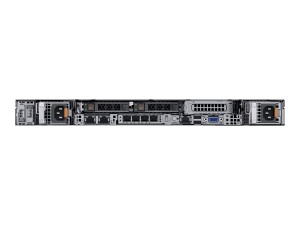
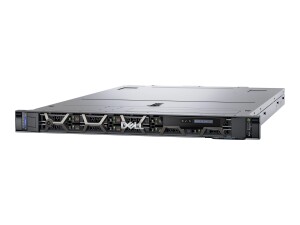















A server (derived from Latin "servus," meaning servant) is commonly understood as a computer system used in large corporate networks, where all the main processes of the network are anchored. A distinction must be made between server hardware, also known as "host," and server software. While hardware refers to the physical components, software refers to the server operating system and other applications that define the possible services that can be provided. Servers are also responsible for communication with workstations, known as clients, and control them.
Types of servers:From a hardware perspective, servers differ not only in the performance capabilities of the components used but also in their structure. There are tower and rack variants that have a similar composition to conventional PC systems. However, the individual components are used in a special server version and are often redundantly designed. Two power supplies, multiple processors, or significantly more memory modules are not uncommon. Blade servers take it a step further. They are fully modular and can be easily expanded with blades to increase performance. The redundancy of components is particularly useful in minimizing downtime. For example, if one power supply fails, the other immediately takes over without requiring a server restart. Additionally, the replacement of individual hardware components often occurs during operation, which is why, for example, hard drives are accessible from the outside in almost all cases. Due to the fact that a server often serves many users and depends on the desired server services, it is recommended to equip a server with slightly more power than currently needed. This approach pays off in a longer service life.
Available server software:Servers are special computers designed to provide various services, applications, and resources. They deliver data to other computers or devices and allow users to access shared files and applications. There are a variety of server types that can be used for different purposes.
The most well-known server types include web servers, database servers, file servers, email servers, and application servers. Each server type is designed for a specific function and offers different characteristics. A web server receives requests from web browsers and sends back the corresponding data. A database server stores and manages databases that can be accessed by multiple users simultaneously. A file server is designed for the storage and sharing of files and documents among multiple users. An email server enables the receipt and sending of emails and the management of email accounts. An application server is responsible for executing applications.
Servers can be operated either physically or virtually. Physical servers are standalone hardware computers that have been specifically configured and set up for server operation. Virtualized servers, on the other hand, are virtual computers operated within a host computer and controlled by it.
Servers can also be managed in various ways. Some servers can be remotely managed through a network connection, while others require physical connectivity for management. Server management can involve monitoring performance indicators, managing user accounts and access rights, as well as installing and maintaining software.
One of the most important characteristics of servers is their reliability. Since servers often store and process critical business data and applications, they need to be available and functioning without interruption around the clock. For this reason, servers are usually equipped with redundant components such as power supplies and hard drives to avoid failures.
Servers can also be exposed to security threats, especially when they are accessible via the internet. Therefore, servers need to be protected with firewalls, antivirus software, and other security mechanisms to ensure the security of data and applications.
In addition to the aspects mentioned, there are other features that are important for servers. These include scalability, which refers to the ability to expand the server's capacity to meet increasing demands, as well as performance, which ensures fast and reliable operation. Maintainability is also a factor, allowing the server to be effectively maintained and repaired when necessary.
File Server:
A file server is an essential component of a company's IT infrastructure as it enables central storage and management of files. This can facilitate file organization, file sharing, and data backup. A file server can be either a computer program or a physical device specifically designed for file management.
File servers allow users to access and share shared files and folders. File and folder sharing is a crucial aspect of collaboration within companies, enabling multiple users to access the same resources. This can enhance efficiency and facilitate collaboration.
In companies, it is often necessary to organize and manage access to shared files and folders. A file server can assist by allowing administrators to restrict access to files and folders based on roles and permissions. For example, access to specific files or folders can be limited to certain departments or employees.
Another advantage of file servers is the ability to perform regular backups of important data. This can help prevent data loss due to hardware failures, viruses, or human errors. By centrally storing data on a file server, backup processes can be performed more efficiently and easily.
File servers also provide higher security for shared files and folders. Through centralized management, administrators can control the security settings of files and folders, preventing unauthorized access. It is also possible to secure file transfers through encryption, ensuring that only authorized users can access the files.
Email Server:
An email server is an essential component of the IT infrastructure of companies and organizations as it enables the exchange of emails. An email server can be either a computer program or a physical device specifically designed for email management.
Email servers are used in companies and organizations to organize and manage the exchange of emails between employees and clients. Emails are a crucial aspect of communication in businesses and are commonly used for internal communication as well as exchanging information with customers and partners.
An email server allows users to send and receive emails. A user can use their email address and password to log in to an email server and send and receive emails. The email server is capable of receiving and storing emails sent from other email servers. When a user sends an email, it is forwarded to the recipient's email server and stored in their inbox.
Email servers also enable the organization of emails. In companies, email servers can be used to organize emails into different folders or categories. This can enhance efficiency and allow users to quickly access important emails.
Another advantage of email servers is the ability to perform regular backups of emails. This can help prevent data loss due to hardware failures, viruses, or human errors. By centrally storing emails on an email server, backup processes can be performed more efficiently and easily.
Email servers also provide enhanced security for emails. By utilizing encryption, emails can be protected from unauthorized access. Additionally, email servers can be equipped with spam filters and antivirus programs to block unwanted emails and malicious attachments.
Web server:
A web server is a crucial component of the IT infrastructure of companies and organizations as it enables the publication and accessibility of web pages on the internet. A web server can be either a computer program or a physical device specifically designed for managing web pages.
Web servers allow companies and organizations to present their content and services online. By using web servers, users worldwide can access this information. Web servers can also be used to provide internal web applications within companies that are accessible only to employees.
A web server operates by transferring data between a client and a server. The client is typically a web browser that sends a request to the web server to display a specific web page. The web server receives this request and sends the requested data back to the client. The requested data can typically include HTML code, images, videos, or other multimedia content.
Web servers can also offer various features and services to enhance user convenience and efficiency. For example, some web servers provide the ability to personalize webpage content, while others can accelerate data transfer through compression. Web servers can also be connected to databases and other applications to generate dynamic web content.
Web servers can be operated with different operating systems and applications. The most well-known web server software programs include Apache, Nginx, and Microsoft IIS. These programs offer various features and configuration options to meet the users' requirements.
Another crucial aspect of web servers is security. Web servers can be vulnerable to attacks such as denial-of-service attacks or cross-site scripting attacks. For this reason, web servers need to be regularly updated and maintained to address potential vulnerabilities and enhance the security of the web pages.
Application server:
An application server is a crucial component of the IT infrastructure of companies and organizations as it provides specialized applications essential for the smooth operation of the business or organization. An application server can be either a computer program or a physical device specifically designed for managing applications.
Application servers enable companies and organizations to deploy specialized applications tailored to their specific needs. These applications can include Enterprise Resource Planning (ERP) or Customer Relationship Management (CRM), for example. By using application servers, companies and organizations can automate and streamline their business processes.
An application server operates by transferring data between a client and a server. The client is typically an application that sends a request to the application server to perform a specific function. The application server receives this request and executes the requested function. The requested functions can typically include data queries, business processes, or other complex operations.
Application servers can also offer various features and services to enhance user convenience and efficiency. For example, some application servers provide the ability to personalize the application's user interface, while others can enhance processing speed through caching and other technologies. Application servers can also be connected to databases and other applications to automate complex business processes and data queries.
Application servers can be operated with different operating systems and applications. The most well-known application server software programs include Java Application Server (JAS), Microsoft Application Server (MAS), and Apache Tomcat. These programs offer various features and configuration options to meet the users' requirements.
Another crucial aspect of application servers is security. Application servers can be vulnerable to attacks such as SQL injection attacks or cross-site scripting attacks. For this reason, application servers need to be regularly updated and maintained to address potential vulnerabilities and enhance the security of the applications.
Database server:
A database server is a vital component of any modern IT infrastructure. Database servers provide centralized storage and management of data for companies and organizations. They enable the storage and management of large amounts of data in a structured manner, thereby improving the efficiency and productivity of businesses.
A database server consists of software that runs on a physical server. The software allows users to create, edit, and access databases. Database servers offer a variety of features and tools to facilitate the management of databases.
Database servers can run on various operating systems such as Windows, Linux, or Unix. The most well-known database servers are Oracle, Microsoft SQL Server, MySQL, and PostgreSQL.
The key functions of a database server include storing and retrieving data, data backup, providing security and data protection features, and optimizing database performance. A database server also offers an interface through which users can access the database, such as through SQL.
Database servers are used in companies and organizations in various applications, such as e-commerce systems, customer relationship management (CRM), financial and accounting systems, inventory management systems, and many other applications. Some companies also operate their own database servers for their specific requirements.
The security of database servers is an essential aspect of implementing and managing databases. A database server can be secured through various methods, such as implementing access controls, encrypting data, monitoring and logging activities, and performing regular backups.
Print server:
A print server is a computer program or a physical device that enables centralized printing of documents. Such a server is typically used in companies and organizations to organize and manage document printing.
Usually, a print server is a standalone computer or dedicated hardware with print server software installed on it. This software allows the server to receive and process print jobs from multiple computers or other devices on the network. The print server can also be connected to one or more printers located near the server.
A major advantage of using a print server is that it allows for the shared use of multiple printers on the network. For example, if a company or organization has multiple departments, each with its own printers, a print server can be used to ensure that all users can access all printers. This means that users do not have to switch printers every time they want to print from a different workstation.
Another benefit of using a print server is that it organizes and prioritizes print jobs from users in a queue. When multiple users are printing simultaneously, the print server can process print jobs in the order they were received. This ensures that print jobs are processed evenly and that no user is given preference.
Furthermore, a print server allows for control over access to specific printers. This is particularly useful when companies or organizations need to print confidential documents that should only be viewed by specific users. The print server can be configured to allow access to specific printers only for authorized users.
Media server:
A media server is an essential component for companies and organizations that need to store and manage large amounts of multimedia content such as videos, audio files, images, and other digital media. A media server can be either a standalone computer program or a physical device specifically designed for storing and delivering media content.
The media server allows companies and organizations to centrally store their multimedia content and provide easy access for users. Centralized storage ensures that media content can be managed securely and efficiently. The media server can also provide features to facilitate searching, organizing, and delivering media content.
An important aspect of a media server is storage capacity. Since multimedia content often requires a significant amount of storage space, it's crucial for the media server to have sufficient capacity to support the stored media content. This can be achieved through the use of hard drives, network storage, or other storage solutions.
A media server can also provide streaming capabilities to enable playback of multimedia content over networks. This allows users to watch or listen to videos or audio files in real-time without having to download the entire file. Streaming enables efficient use of bandwidth and ensures seamless content playback.
In addition, a media server can offer features for media format conversion and transcoding. This is particularly useful when the media content is available in different formats and needs to be played on various devices. The media server can automatically convert the media content into the appropriate format to enable optimal playback on different devices.
Security is another important aspect when using a media server. Since multimedia content can often contain valuable or sensitive information, it's important for the media server to have appropriate security measures to control and protect access to the content. This can be achieved through the implementation of access rights, encryption, and other security mechanisms.
Game server (Spielserver):
A game server is a central component for the provision of online games and multiplayer games. It is a computer program or a physical device used by game developers and companies to allow players to participate in games together, regardless of their location.
The main purpose of a game server is to provide a platform where players can interact with each other. By using a game server, multiple players can participate in a game simultaneously, whether it's cooperative or competitive games. The server acts as a mediator and coordinator among the players by synchronizing their actions and managing the current game state.
The key functions of a game server include managing game rooms or instances where players can gather and play. This allows players to meet and interact in a virtual environment. The server ensures that the game rules are enforced and that all players have the same experience.
Another important aspect of a game server is matchmaking. The server helps to find players with similar skills and interests to ensure a balanced gaming experience. By using matchmaking algorithms, players with similar performance levels and play styles can be brought together to enable exciting and fair competitions.
Communication between players is also a crucial part of a game server. The server allows players to communicate with each other, whether through text chat, voice chat, or other communication means. This allows players to coordinate their strategies, exchange information, and experience social interactions.
The performance of a game server is critical to ensure a smooth gaming experience. A well-configured and powerful server minimizes latency, reduces delays, and enables a fast and responsive gaming environment. This is especially important in fast-paced and action-packed games where low latency can be crucial.
Security is another important aspect of game servers as they often process sensitive user data such as account information or personal data. The server needs to implement appropriate security measures to prevent unauthorized access, fraud, or hacking. This includes the implementation of encryption, access controls, and monitoring systems.
Virtualization server (Virtualisierungsserver):
A virtualization server, also known as a hypervisor, is a computer program or a physical device responsible for virtualizing physical servers or other computers. Its main task is to allow users to create, manage, and run multiple virtual machines on a single physical server. Virtualization technology optimizes resource utilization, improves efficiency, and reduces hardware costs.
The virtualization server acts as a type of operating system for the virtual machines. It manages the physical resources of the server, such as the processor, memory, storage space, and network ports, and assigns them to the virtual machines. This allows multiple operating systems and applications to run independently on the same physical server, as if they were installed on separate physical machines.
Virtualization offers a number of advantages. By consolidating multiple servers onto a single physical server, space can be saved, energy consumption reduced, and management simplified. Virtualization also enables better resource utilization, as unused capacities can be shifted from one virtual server to another to meet demand. This results in more efficient utilization of existing hardware.
The virtualization server can use various virtualization technologies, such as hypervisor-based virtualization or container virtualization. With hypervisor-based virtualization, a software layer is created between the physical server and the virtual machines, enabling resource management and isolation. With container virtualization, applications run in isolated containers that share the host kernel, allowing efficient resource utilization.
The management and configuration of a virtualization server typically involve creating and deploying new virtual machines, allocating resources, monitoring performance, patching and updating the hypervisor, backing up and restoring virtual machines, and implementing security measures.
Security plays a crucial role in virtualization. The virtualization server needs to implement mechanisms to ensure the integrity, confidentiality, and availability of the virtual machines and their data. This includes access controls, encryption, firewalling, and other security measures.
Cloud server (Cloud-Server):
A cloud server is a virtual server hosted in the cloud, allowing businesses and users to access shared IT resources provided by a cloud provider. Unlike traditional physical servers that are operated locally in a data center, cloud servers are deployed in a virtual environment and managed by a third-party provider.
Using a cloud server offers several advantages. Firstly, it enables scalability. Businesses can increase or decrease the resources of their cloud server as needed to adapt to changing demands. This allows them to flexibly respond to peak loads or seasonal fluctuations without the need to purchase and implement additional physical hardware.
Another advantage is flexibility. Cloud servers allow businesses to run different operating systems, applications, and services on a single platform. Users can access their cloud servers over the internet from anywhere and from various devices, facilitating remote work and mobile operations.
A cloud server also provides high availability and fault tolerance. Cloud providers typically operate multiple data centers in different locations to ensure redundancy and continuous operation. This reduces the likelihood of downtime as traffic can be automatically redirected to other available servers in case of issues.
Security of cloud servers is an important aspect. Cloud providers implement security measures to ensure the integrity, confidentiality, and availability of data. These measures include robust access controls, encryption, firewalls, regular security updates, and monitoring systems. However, it's important for businesses to take their own security measures, such as securely configuring applications and regularly reviewing security settings.
The management of a cloud server is typically done through a web-based user interface or an application programming interface (API). Users can create, configure, and manage virtual machines, allocate resources, set up networks, implement security policies, and monitor performance. The cloud platform often provides tools for automated deployment and scaling of applications, as well as data backup and recovery.
Cost is an important factor when using a cloud server. Most cloud providers offer their services based on a pay-as-you-go model, where customers only pay for the resources they actually use. This allows for a flexible and scalable cost structure, as businesses only pay for what they need without making capital investments in hardware and infrastructure.
Proxy Server (Proxy-Server):
A proxy server is a computer program or a physical device that acts as an intermediary between a client and other servers or the internet. It receives requests from a client, forwards these requests to the corresponding destination servers, receives the responses, and then sends them back to the client. It hides the client's identity and enables a variety of functions to filter, accelerate, secure, and protect user privacy in the traffic.
One of the main purposes of a proxy server is to filter and control traffic. By implementing access controls, a proxy server can restrict access to specific websites or content based on predefined rules. This can be used in enterprises to block access to inappropriate or unauthorized content and ensure compliance with corporate policies. A proxy server can also be used to block certain types of content, such as advertisements or malicious files.
Another important aspect of a proxy server is accelerating traffic. By serving as a cache for frequently requested data, a proxy server can speed up access to that data. When a client makes a request, the proxy server first checks if it has the corresponding data in its cache. If it does, it can immediately deliver the data to the client without having to forward the request to the destination server. This reduces latency and relieves network resources.
Security is another important aspect of a proxy server. A proxy server can act as an additional layer of protection by monitoring traffic and blocking unwanted or malicious content. It can also implement encryption techniques such as SSL/TLS to ensure the security of transmitted data. Additionally, a proxy server enables anonymization of traffic by hiding the client's IP address, thus protecting user privacy.
There are different types of proxy servers, including:
A proxy server can either function as a dedicated server or be installed on a general server or network component such as a router. Configuring and managing a proxy server involves defining rules and filters, controlling access, monitoring traffic, logging activities, and implementing security measures such as encryption and authentication.
There are various proxy server software solutions available to businesses and users, including both open-source and commercial options. Popular proxy server software solutions include Squid, Apache HTTP Server with Mod_proxy, Nginx, HAProxy, and Microsoft Internet Security and Acceleration (ISA) Server.
It is important to note that a proxy server is not the same as a Virtual Private Network (VPN). While both can enhance privacy and security, they work in different ways. A proxy server operates at the application level and forwards traffic for specific applications or protocols, whereas a VPN encrypts all device traffic and redirects it through a remote server. VPNs provide more comprehensive privacy and security, while proxy servers offer more specific functions and work at the application or protocol level.
DNS Server:
A DNS server (Domain Name System) is an essential component of the internet and plays a crucial role in translating domain names into IP addresses. It acts as a kind of internet phone book that allows users to access websites via URLs by translating the domain name into a numerical IP address.
The DNS server forms a hierarchical structure known as the DNS tree or DNS hierarchy. This hierarchy consists of various levels, starting with the top-level called the root DNS server, followed by top-level domains (TLDs) such as ".com," ".org," or ".de." Within the TLDs, there are further levels defined by registrars and domain owners.
When a user enters a URL into their web browser or clicks on a link, the browser sends a DNS request to the DNS server to determine the IP address of the specified domain. The DNS server then traverses the DNS tree and sends requests to various DNS servers to find the IP address.
A DNS server can manage various types of DNS records, including:
The DNS server stores these DNS records in its DNS database to expedite and efficiently manage the resolution of domain names. This database is regularly updated to reflect changes in DNS records made by registrars or domain owners.
There are different types of DNS servers, including:
DNS servers play a crucial role in the functioning of the internet as they enhance user experience and enable communication between different computers and servers. They allow users to use domain names instead of complex IP addresses, making internet navigation easier.
In addition, DNS servers also provide functions such as caching and load balancing. By storing DNS responses in their cache, DNS servers can improve resolution speed and reduce traffic by quickly responding to repeated requests for the same domain. Load balancing features enable DNS servers to distribute requests across multiple servers to optimize load and achieve better scalability.
The security of DNS servers is also of great importance. There are various security mechanisms such as DNSSEC (DNS Security Extensions) that ensure the integrity and authenticity of DNS records to prevent attacks like DNS spoofing or DNS manipulation.
In businesses and organizations, DNS servers are often operated internally to manage internal name resolution and access to internal resources. There are also public DNS servers operated by internet service providers or third parties that can be used for general name resolution on the internet.
Backup Server:
A backup server is an essential component of data management and plays a crucial role in data backup and recovery. It allows businesses and users to automatically back up important data and restore it when needed, protecting against data loss, hardware failures, human errors, or other unforeseen events.
The main function of a backup server is to create copies of data and store them in a secure location. This is typically done at regular intervals to ensure that the latest versions of the data are backed up. Backup can be performed in various ways, such as full, incremental, or differential backups.
The backup server can secure various types of data, including files, databases, emails, system configurations, and more. Depending on the requirements and scope, different backup strategies can be implemented to ensure that all important data is covered.
Backups are typically stored on physical storage media such as hard drives, tape drives, or network storage. However, in modern environments, cloud-based backup solutions are often used, where data is backed up in the cloud. This provides benefits such as scalability, reliability, and the ability to access the backed-up data from anywhere.
An important aspect of performing backups is ensuring the integrity of the data. This includes verifying the backups to ensure that they completed successfully and that the data can be restored correctly. Verification mechanisms such as integrity checks, checksum comparisons, or test restores are used to ensure that the backed-up data is intact and can be reliably restored in case of data loss.
In addition to data backup, the recovery function of the backup server is crucial. In the event of data loss, whether due to accidental deletion, hardware failures, or other incidents, the backup server allows for the restoration of the backed-up data.
VoIP Server:
A VoIP server (Voice over IP) is an essential component for providing voice communication over the internet. It allows users to make phone calls over the internet by converting voice data into digital signals, transmitting them over the IP network, and forwarding them to the receiver.
The VoIP server plays a crucial role in implementing VoIP services and offers a variety of features to ensure effective and smooth voice communication. Here are some of the important functions that a VoIP server can provide:
A VoIP server can be operated either as a standalone physical device or as a software application. In many cases, a dedicated VoIP server is used, which is specifically optimized for processing voice data and has powerful hardware and network capabilities.
The VoIP server works closely with other components of the VoIP system, such as IP phones, softphones, gateways, and PBX (Private Branch Exchange) systems. It handles the management of VoIP calls, conversion of voice data into IP packets, call signaling, as well as routing and connection establishment processes.
In addition to processing voice data, a VoIP server can also provide additional functions, such as the integration of Unified Communications (UC) services. This involves bringing together various communication channels such as voice, video, instant messaging, and file sharing into a unified platform.
The implementation of a VoIP server offers numerous benefits for businesses and users, including:
Messaging Server:
A messaging server is a computer program or a physical device that enables the management of messaging services. It plays a crucial role in providing real-time chat and instant messaging capabilities to users, regardless of their physical location or the devices they use. A messaging server allows users to communicate across various platforms, whether it's through computers, smartphones, tablets, or other internet-enabled devices.
The messaging server provides a variety of features to ensure effective and seamless communication. Here are some of the important features that a messaging server can provide:
Using a messaging server offers numerous advantages for businesses and users. These include:
IoT Server (Internet of Things):
An IoT server (Internet of Things) is a computer program or physical device responsible for managing and controlling IoT devices. The IoT server plays a central role in integrating and coordinating IoT devices to collect data, analyze it, and execute corresponding actions. It enables businesses and users to efficiently manage and interact with their IoT devices.
An IoT server provides a variety of features to ensure seamless and effective communication and control of IoT devices. Here are some of the important functions an IoT server can provide:
Terminal Server:
A terminal server, also known as a remote desktop server or thin client server, plays an important role in providing remote desktop services. It allows users to access a central desktop and run applications over the internet or a local network as if they were physically sitting in front of the computer. Here are some key aspects that distinguish the terminal server:
Data Storage:
Data storage and management are one of the key tasks of servers in businesses. Servers serve as central storage platforms where databases, files, and other information can be securely and efficiently stored, organized, and managed. Here is a detailed description of this task:
Resource Provisioning:
Resource provisioning is a central function of servers in businesses and organizations. Servers provide a variety of IT resources required for the smooth operation of applications, data processing, and other business tasks. The following are various aspects of resource provisioning by servers:
Application Deployment:
Application deployment is one of the central functions of servers in businesses and organizations. Servers enable the execution of various applications and services that are crucial for smooth operations and business success.
Network Connection and Communication:
Network connection and communication are essential functions of servers as they serve as nodes to connect users, devices, and other servers, enabling communication through network protocols. Servers play various roles such as routers, switches, gateways, or firewalls to control, filter, and secure the traffic.
In addition, servers offer further functions for network connection and communication:
Access Control and Security:
Access control and security are essential aspects for protecting IT systems, and servers play a central role in this regard. They implement a variety of mechanisms to control access to resources and ensure the security of sensitive data. Here are some key aspects of access control and security implemented by servers:
Scalability and Load Balancing:
Scalability and load balancing are critical aspects of efficiently utilizing servers in an IT infrastructure. Scalability allows businesses to adjust their resources to meet growing demands, while load balancing ensures that these resources are evenly distributed across servers. Here is more information about these concepts:
There are different types of clustering:
High Availability Clustering: In this type of clustering, two or more servers are grouped into a cluster, with one acting as the primary server and handling the workloads. If the primary server fails, a secondary server automatically takes over the tasks to ensure service continuity.
Load Balancing Clustering: In this type of clustering, multiple servers share the workloads by distributing requests. The load is intelligently distributed across the available servers to ensure optimal utilization and performance. This load distribution helps avoid bottlenecks and enhances scalability.
Geographical Clustering: Geographical clusters have cluster nodes located at different geographic locations. This provides high fault tolerance and improved performance for users in different locations. In the event of a site failure, services can seamlessly be taken over by another location.
The combination of scalability, load balancing, and clustering allows businesses to efficiently utilize their IT infrastructure and respond to increasing demands. It provides flexibility, fault tolerance, improved performance, and optimal resource utilization. By scaling and distributing workloads, companies can deliver smooth and reliable services to their users, regardless of the size of the company or the traffic volume.
Data Backup and Recovery:
Data backup and recovery are critical aspects of a company's IT infrastructure. Servers play a central role in implementing backup and recovery mechanisms to ensure data integrity and availability.
A server can support various backup methods, including:
Servers can also support various backup frequencies, such as daily, weekly, or monthly backups, depending on the requirements of the business.
In addition, servers provide data recovery features in the event of a system failure or data loss. This can be done either by restoring a full backup or selectively restoring specific files or directories. Servers also enable fast data recovery by providing tools and mechanisms for efficient data restoration.
To ensure the integrity and availability of the backed-up data, it is important to store the backup data in a secure location. This can be done on physical media such as tape drives, hard drives, or in the cloud. Access to the backup data should be strictly controlled and encrypted to prevent unauthorized access.
Regularly reviewing and updating the backup strategy is also crucial to ensure that the data is adequately protected and that the recovery mechanisms function effectively.
Monitoring and Troubleshooting:
Servers are often equipped with monitoring tools to monitor performance, availability, and utilization. By monitoring system resources, network connections, and application performance, server administrators can identify potential issues and take appropriate troubleshooting measures. Monitoring and troubleshooting are essential to ensure the smooth operation of the server system and minimize downtime.
Servers are equipped with specialized monitoring tools that allow continuous monitoring of various parameters, including:
The monitoring results are captured in real-time and provided in the form of reports, dashboards, or alert notifications. Server administrators can use this information to analyze server operations and identify potential issues.
In the event of errors or disruptions, server administrators can refer to the monitoring data to determine the causes of the errors and take appropriate actions to resolve the problem. This may involve restarting services, performing system updates, redirecting traffic to alternative servers, or implementing load balancing mechanisms.
In addition, servers also support automatic troubleshooting through the implementation of scripts or script-based tools. These scripts can identify specific error patterns and automatically take measures to resolve the issue without the need for human intervention.
Monitoring and troubleshooting servers are continuous processes that help maintain the availability, performance, and security of the server system. Effective monitoring and quick troubleshooting enable server administrators to proactively address issues and ensure smooth and reliable server network operation.
Advantages of servers:
Disadvantages of servers:
Conclusion:
In summary, servers play an essential role in the IT infrastructure of companies and organizations. They provide a variety of functions and enable the efficient provision of resources, storage and management of data, ensuring availability and reliability, enforcing security measures, and complying with compliance requirements. Servers support enterprise applications, web applications, email services, databases, games, and many other services.
By using servers, companies can effectively and efficiently support their business processes. Servers enable the execution of enterprise applications and the integration of various systems, allowing employees to work more efficiently and perform tasks such as resource management, customer support, and project management. In the web hosting domain, servers provide the infrastructure to host websites and web applications. They provide the necessary computing power to process web content, enable interactive features, and strengthen a company's online presence.
Servers also play a crucial role in providing email services. They host email servers that support internal and external communication. By using servers, companies can manage their email accounts, securely send and receive emails, and implement security measures such as encryption and spam filtering. This ensures reliable communication and effective collaboration among employees.
The central storage and management of databases is another important application area of servers. Database servers ensure that critical business data can be stored, retrieved, and scaled securely and reliably. Companies use databases to store, retrieve, and analyze information to make informed business decisions.
Servers are also used in the gaming industry to host and manage online games and multiplayer games. By using dedicated game servers, players can interact, play, and enjoy an immersive gaming experience worldwide. Servers enable the management of game rooms, matchmaking, and provide a responsive and secure environment for players.
Furthermore, servers play a crucial role in network connectivity and communication. They act as communication nodes and provide functions such as routing, switching, gateway, firewall, DHCP, DNS, VPN, proxy, load balancing, virtualization, as well as monitoring and troubleshooting. Servers ensure that users, devices, and other servers are interconnected, enable secure data transmission, and ensure efficient utilization of network resources.
Another important aspect of servers is access control and the security of IT systems. Additionally, servers provide mechanisms for data backup and recovery to minimize data loss and quickly resume business operations even after severe disruptions or failures. Regular backups of data on servers ensure that important information is secured and can be restored when needed. Moreover, servers can implement redundancy and failover mechanisms to ensure service availability. By setting up redundant servers and automatically switching to a backup server in case of failure, business continuity is ensured.
Security is another crucial aspect of servers. Servers implement various security mechanisms to ensure the integrity, confidentiality, and availability of data and resources. These mechanisms include authentication, encryption, firewalling, logging, and patch management. Servers play a vital role in access control and protection against unauthorized access. By implementing firewalls and intrusion detection systems, servers can filter unwanted traffic and detect potential threats. Logging and monitoring allow servers to record security incidents and enable quick response and troubleshooting.
Scalability and performance are also critical factors of servers. Companies can scale their server infrastructure according to their needs by adding additional servers or expanding the resources of existing servers. By implementing load balancing mechanisms, servers can distribute the load across multiple servers, improving the performance and availability of applications. Virtualization servers enable companies to run multiple virtual machines on a single physical server, resulting in more efficient resource utilization and cost savings.
In conclusion, servers play a diverse and crucial role in companies and organizations. They provide the necessary infrastructure and services to efficiently operate applications, databases, email services, games, and other resources. Servers ensure the storage, management, and security of data, enable collaboration and communication, improve efficiency and productivity, offer scalability and performance, ensure business continuity, and ensure the integrity and availability of data and resources. Servers are thus indispensable components of IT infrastructure and play a vital role in supporting business requirements and optimizing workflows.





| id | title | mpn | price | manufacturer |
|
from *
/ |

